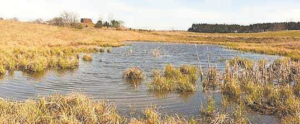This article, by Paul A. Smith, was originally published in the Milwaukee Journal Sentinel, Thursday, September 10, 2020 edition.
WWA has re-published this article with the express permission of author Paul Smith.

Isolated wetlands such as this shallow, seasonal pond on a farm in St. Croix County are no longer protected under federal rules. Tracy Hames
When it comes to politics and religion, I’m not a bumper-sticker kind of guy.
I’ve always felt such matters are best kept private.
But I do unabashedly endorse holding our elected representatives accountable and not blindly giving support to a candidate based on their part.
I’d like to think all voters would apply the same standards.
Whether you normally identify as a Democrat or Republican or Independent, or if you consider yourself a conservationist or an environmentalist, the season is high to ask candidates where they stand on issues that matter most to you.
This pre-election period is when we – the voting public, a.k.a. “the bosses” – have the most leverage over politicians.
You’ve no doubt started to receive literature from candidates in races for Wisconsin legislative seats.
As they ask for your vote in the Nov. 3 election, make sure you ask them questions now.
If outdoor recreation, clean water and public lands are important to you, here’s two issues that should be on your radar: reauthorization of the Knowles-Nelson Stewardship Program and an increase in the price of the Wisconsin waterfowl stamp.
Both have been beneficial to state residents, both are supported by large majorities in surveys and both need action by state officials, either in the 2021-22 state budget or in separate legislation.
First the KNSP, which, since it was established by the Legislature in 1989, has been Wisconsin’s primary tool for land acquisition and conservation.
Over the last three decades it has protected more than 669,000 acres of state property.
Projects have ranged from 1-acre additions to the Hank Aaron State Trail in Milwaukee to 100-square-mile purchases such as the Wild Rivers Legacy Forest in northeastern Wisconsin.
Funding for the program has mostly come from state taxpayers, but has been augmented with federal and private funds. Wisconsin has invested about $1.2 billion in the program since 1989, according to state figures.
The KNSP protects land through fee acquisition of properties, purchase of easements, development of recreational facilities and restoration of wildlife habitat.
It comes with a cost, yes, and even if another acre was never purchased through the program, the state will continue to make debt payments on previous deals.
But as it is sometimes said “they aren’t making any more land.” And the public has shown strong support for the KNSP.
According to a 2015 poll commissioned by the Nature Conservancy and conducted by Public Opinion Strategies, an Alexandria, Virginia-based firm that describes itself as “the nation’s largest Republican pollster,” two-thirds of Wisconsin voters had better impressions of legislators who would support the KNSP.
Specifically, the pollsters asked: “If your State Legislator voted in favor of continuing to protect natural areas, wildlife habitat, and parks in Wisconsin through the Stewardship program, would you have a more favorable impression, a less favorable impression or would that not make a difference in your view of him or her?”
Sixty-seven percent replied “more favorable,” 29% “no difference” and 3% “less favorable.”
In the same poll, nearly 90% of Wisconsin voters felt the Legislature should, even when the budget is tight, continue to invest in protection Wisconsin’s land, water and wildlife.
The Wisconsin waterfowl stamp has had similar support. But in this case, it’s not a program paid for by the general public but by a specific user group – waterfowl hunters.
Duck and goose hunters in Wisconsin are required to purchase a stamp. In addition, some are bought by stamp collectors as well as birders and others interested in contributing to conservation.
Funds raised by stamp sales are used to purchase, protect or rehabilitate wetlands or other habitat crucial to waterfowl. Other species, of course, also benefit, as does water quality.
In that respect, the program is funded primarily by waterfowlers but the dividends also flow to the general public.
Authorized in 1978, proceeds from stamp sales have raised about $18 million over the last four decades.
Surveys of Wisconsin conservation groups in recent years have shown better than 80% support among the ranks of stamp buyers for an increase.
The price of the stamp has been unchanged at $7 since 1997; proposals have suggested increasing it to $12.
A bill introduced in 2019 to increase the stamp by $5 was supported by groups including Ducks Unlimited, the Wisconsin Conservation Congress, the Wisconsin Waterfowl Association and the Wisconsin Wildlife Federation.
The bill did not make it out of committee.
The coronavirus pandemic has underscored the high value of outdoor activities and the strong need for public spaces in Wisconsin.
Reauthorizing the KNSP and beefing up the duck stamp are two ways elected representatives in Wisconsin can help.
I know this is a limited set of issues. But it’s a start.
Whatever outdoors topics are important to you, make sure you know your candidates’ positions before you throw them your support.
